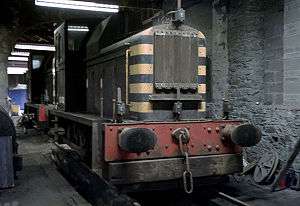British Rail Class 01
|
01002 inside the shed at Holyhead Breakwater. Withdrawn 01001 is just visible at the rear. | |||||||||||||||||||||||||||||||||||||||
| |||||||||||||||||||||||||||||||||||||||
| |||||||||||||||||||||||||||||||||||||||
| |||||||||||||||||||||||||||||||||||||||
| |||||||||||||||||||||||||||||||||||||||
The British Rail Class 01 diesel locomotive was a short wheelbase 0-4-0 diesel-mechanical design intended for use in areas with tight curves and limited clearance.
History
Four examples were built by Andrew Barclay Sons & Co. of Kilmarnock (Scotland) in 1956. They were numbered 11503-11506, then D2953-2956, and two survived long enough to enter the BR TOPS system as 01 001 (D2954) and 01 002 (D2955). Their original depot allocation was to Stratford (30A). A fifth similar locomotive was built in 1958 for departmental stock (maintenance work). It was originally No. 81 but was renumbered D2956 in July 1967 after the original D2956 had been withdrawn.
The locomotives were very versatile, despite having only 153 horsepower (114 kW) available, and were small enough to operate on any railway on the BR standard gauge network — except for the small problem that they were limited to 14 1⁄4 miles per hour (22.9 km/h). For a fleet of just five locomotives, they were also very reliable, although Stratford Docks, where they originally worked, was not noted for creating very hard labour.
01 001 and 01 002 survived in BR service because they were required to service the Holyhead Breakwater, being the only locomotives light enough for that track. 01 001 was not used after 1973 but was cannibalised for spare parts to keep its sister loco in service. 01 001 was withdrawn in 1979, and 01 002 followed in 1981. 01 002 had last run when the Breakwater Railway closed in July 1980 both locomotives were cut up on site still carrying their original livery of British Railways black with black-and-yellow "wasp stripe" warning ends and the original British Railways "unicycling lion" emblem; they were the last locomotives in BR service to do so.
Technical details
Class 01 locomotives had a Gardner 6-cylinder in-line, 4-stroke 6L3 engine of 153 hp (114 kW) at 1,200 rpm connected to a Wilson SE4, 4-speed epicyclic gear box with a Vulcan-Sinclair type 23 rigid hydraulic coupling, and a Wiseman 15LGB reverse and final drive unit. The wheels were connected by coupling rods and driven by a jackshaft.
Preservation
Two survive in preservation:
- D2953 by Heritage Shunters Trust
- the first D2956 on the East Lancashire Railway
Re-use of the '01' TOPS code
More recently, the sub-classification 01/5 has come into use to refer to small, privately owned shunters certified to run on the national network. As such, 01/5 is a collective grouping of a number of very different locomotives, having in common only that they are small, hitherto unclassified shunters of designs never given a BR classification.
References
- Marsden, Colin J. (1981). Motive power recognition:1 Locomotives. Shepperton: Ian Allan Ltd. ISBN 0-7110-1109-5.
- Williams, Alan; Percival, David (1977). British Railways Locomotives and Multiple Units including Preserved Locomotives 1977. Shepperton: Ian Allan Ltd. ISBN 0-7110-0751-9.
External links
- More images of 01002 shunting on the breakwater
- Photo at TheRailwayCentre.com
- Page of photos of 01 002 on Holyhead Breakwater on the Breakwater's official page
